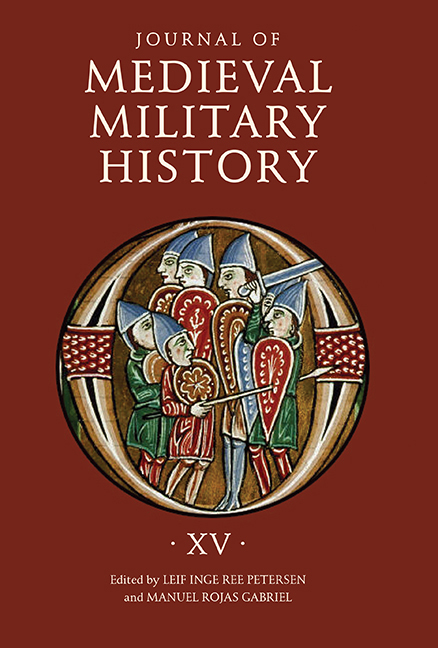Book contents
- Frontmatter
- Dedication
- Contents
- List of Illustrations
- Preface
- 1 Later Roman Grand Strategy: The Fortification of the urbes of Gaul
- 2 In Search of Equilibrium: Byzantium and the Northern Barbarians, 400–800
- 3 Evolving English Strategies during the Viking Wars
- 4 Norman Conquests: A Strategy for World Domination?
- 5 The Papacy and the Political Consolidation of the Catalan Counties, c. 1060–1100: A Case Study in Political Strategy
- 6 Alfonso VII of León-Castile in Face of the Reformulation of Power in al-Andalus, 1145–1157: An Essay in Strategic Logic
- 7 The Treaties between the Kings of León and the Almohads within the Leonese Expansion Strategy, 1157–1230
- 8 A Strategy of Total War? Henry of Livonia and the Conquest of Estonia, 1208–1227
- 9 The English Longbow, War, and Administration
- List of Contributors
- Journal of Medieval Military History
- De Re Militari and the Journal of Medieval Military History
9 - The English Longbow, War, and Administration
Published online by Cambridge University Press: 21 August 2019
- Frontmatter
- Dedication
- Contents
- List of Illustrations
- Preface
- 1 Later Roman Grand Strategy: The Fortification of the urbes of Gaul
- 2 In Search of Equilibrium: Byzantium and the Northern Barbarians, 400–800
- 3 Evolving English Strategies during the Viking Wars
- 4 Norman Conquests: A Strategy for World Domination?
- 5 The Papacy and the Political Consolidation of the Catalan Counties, c. 1060–1100: A Case Study in Political Strategy
- 6 Alfonso VII of León-Castile in Face of the Reformulation of Power in al-Andalus, 1145–1157: An Essay in Strategic Logic
- 7 The Treaties between the Kings of León and the Almohads within the Leonese Expansion Strategy, 1157–1230
- 8 A Strategy of Total War? Henry of Livonia and the Conquest of Estonia, 1208–1227
- 9 The English Longbow, War, and Administration
- List of Contributors
- Journal of Medieval Military History
- De Re Militari and the Journal of Medieval Military History
Summary
In England when medieval warfare is mentioned almost everybody immediately thinks of the longbow. It is the iconic weapon in English military experience and the symbol of victory. To discuss it evokes memories of Crécy and Agincourt. Its status was already long established when it was fixed in people's minds by Laurence Olivier's famous film of Shakespeare's Henry V with the thrilling scenes of Agincourt. Significantly, this was essentially a propaganda film, made during the Second World War. A well-known account of Agincourt speaks of the volleys of arrows making “a weird clanking and banging” as they struck the armor of French men-at-arms. By Tudor times the romance of the longbow was well established. Latimer, bishop of Worcester, preaching in 1549 proclaimed,
“The art of shooting has been in times past much esteemed in this realm. It is a gift of God […] whereby he hath given us many victories against our enemies.” It was probably conservatism and the prestige of the weapon which account for its continuing use in England to the end of the sixteenth century. In 1596 Sir John Smythe was still drilling companies of archers and pikemen in Essex. He was admittedly an eccentric, and his fondness for the bow owed much to its association with the decisive campaigns of the past which he contrasted with the long and indecisive conflicts of the late Elizabethan period. Bows still had limited uses, moreover, notably at long range against cavalry. But by this time England was relatively backward, and continental armies, notably the Spanish Army of the Netherlands, seem almost to have forgotten the weapon.
Underlying the nostalgia of Smythe and others, however, was a reality. There is no doubt that in the fourteenth and fifteenth centuries the longbow was highly important on the battlefield, and archers were a vital part of English armies. Modern academic studies have stressed the role of the heavily-armored men-atarms of the English armies. It was the shrewd combination of these arms and new battle tactics which maximized possibilities of late medieval armies and brought victories. As Clifford Rogers explains of dismounted knights in the tight close-order English formations, “What made these horsemen on foot so effective was their integration with the archers. Because the English formations had missile superiority, their dismounted men-at-arms could not be dispersed by enemy archers.”
- Type
- Chapter
- Information
- Journal of Medieval Military HistoryStrategies, pp. 215 - 226Publisher: Boydell & BrewerPrint publication year: 2017

